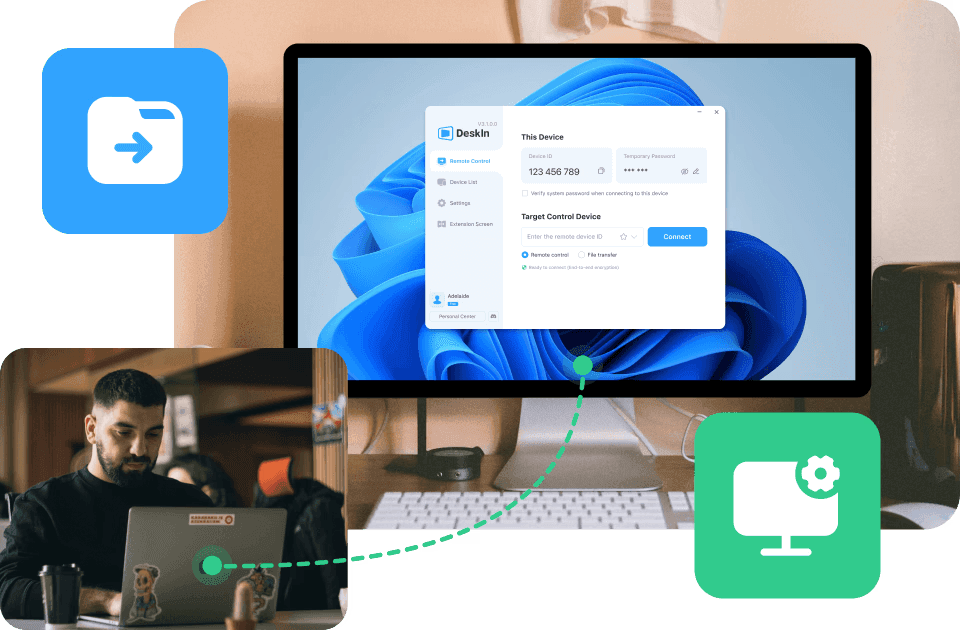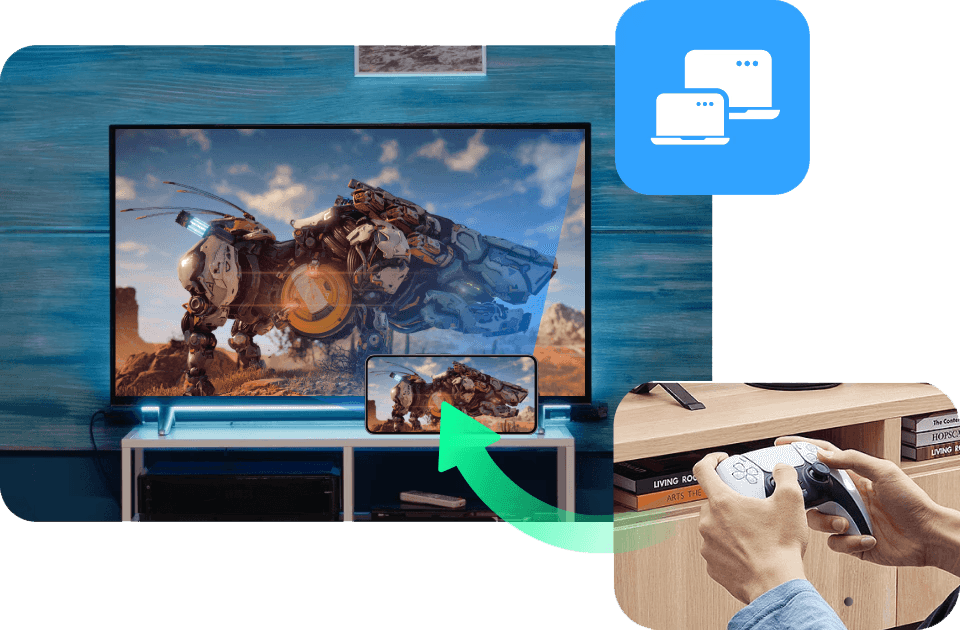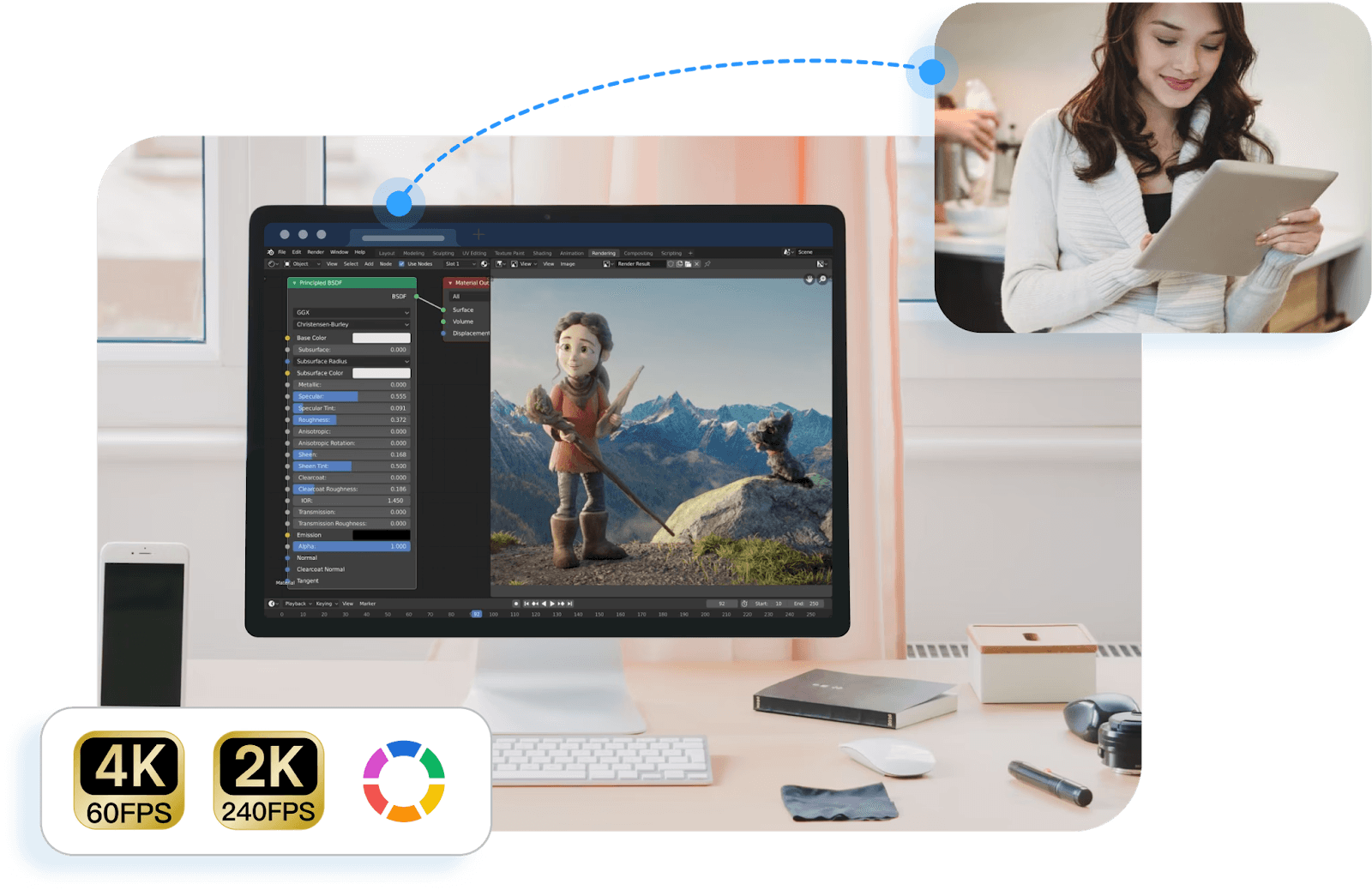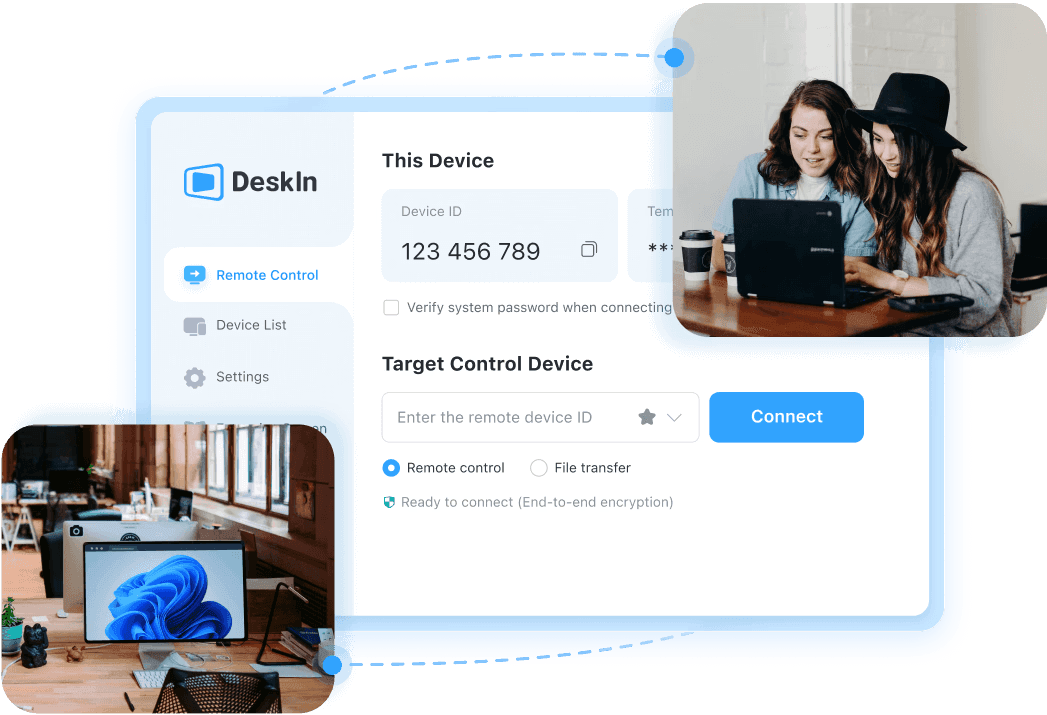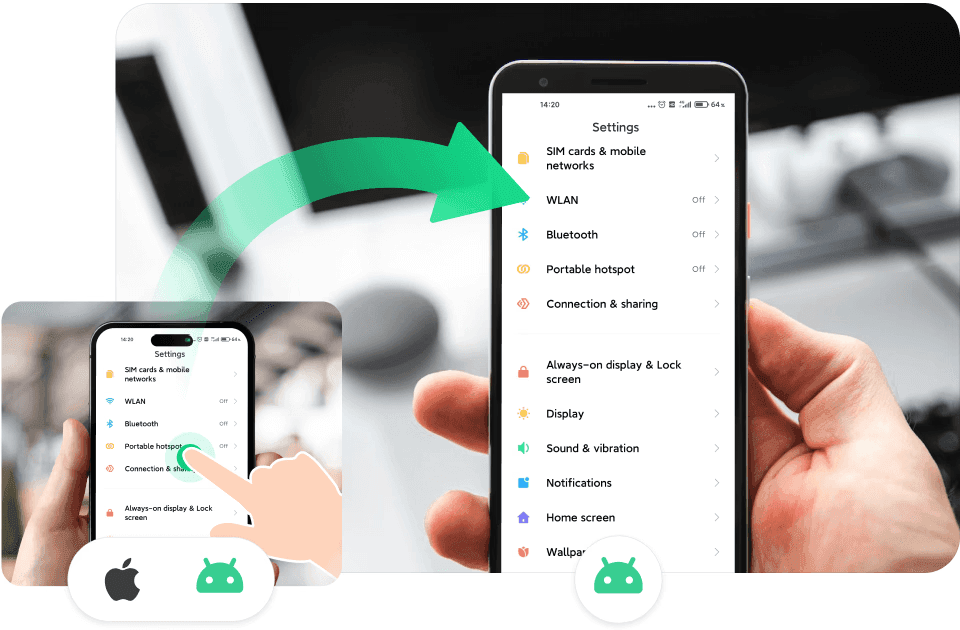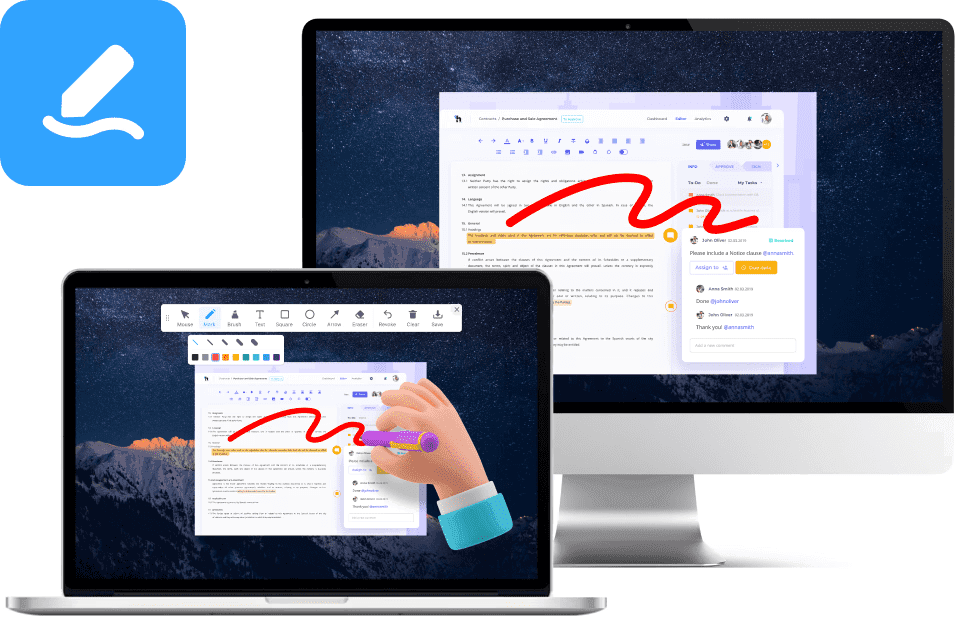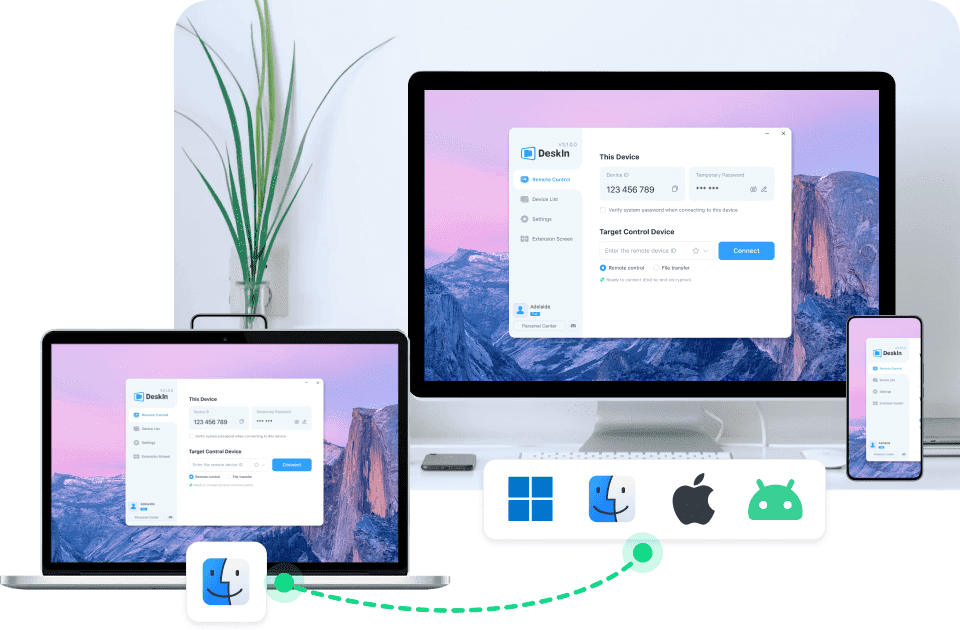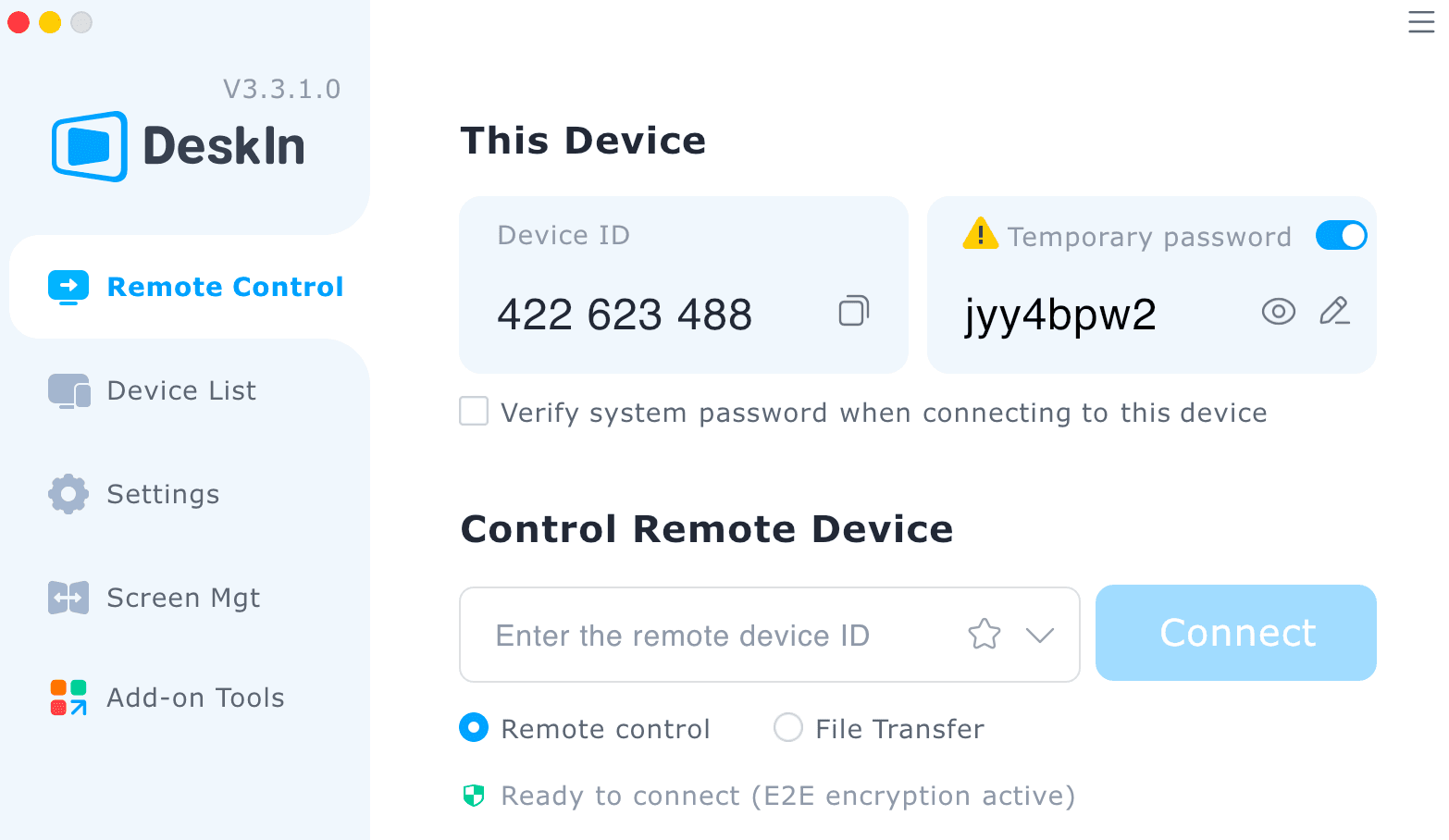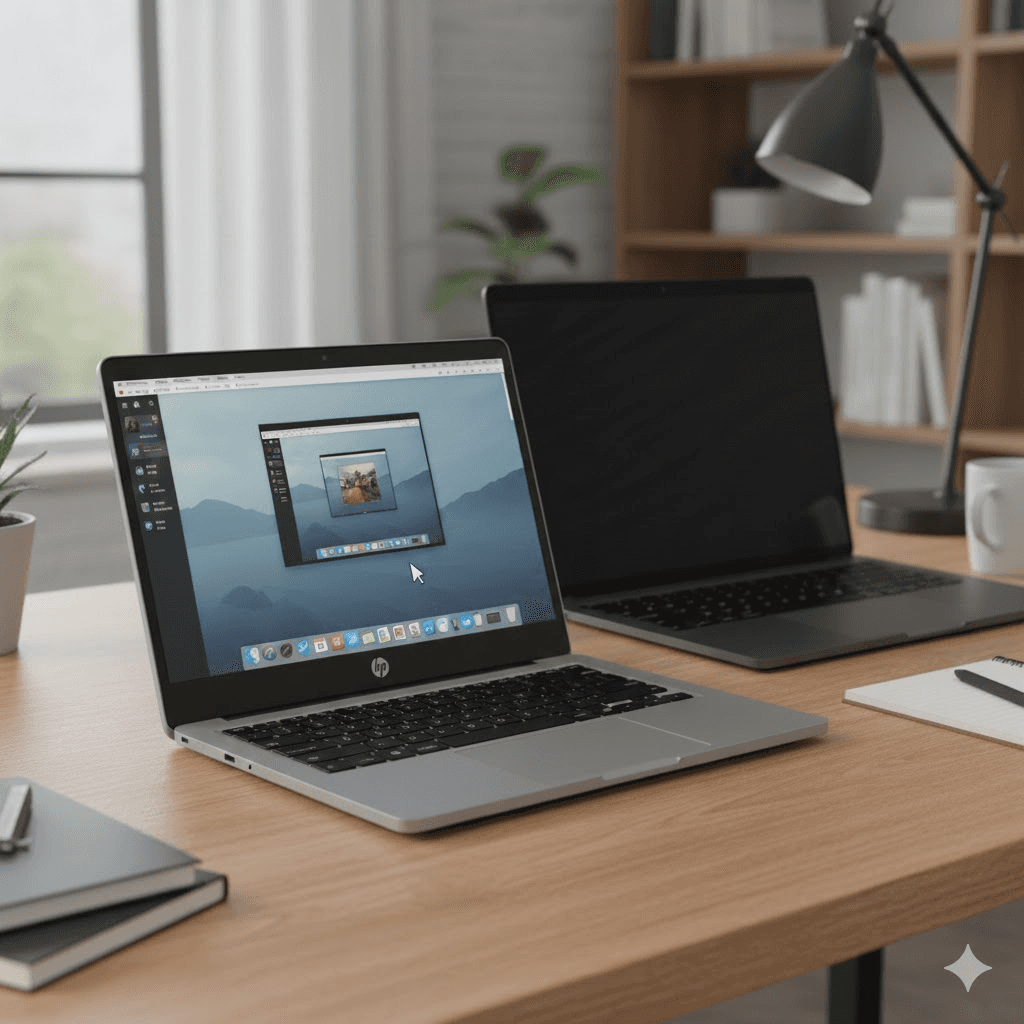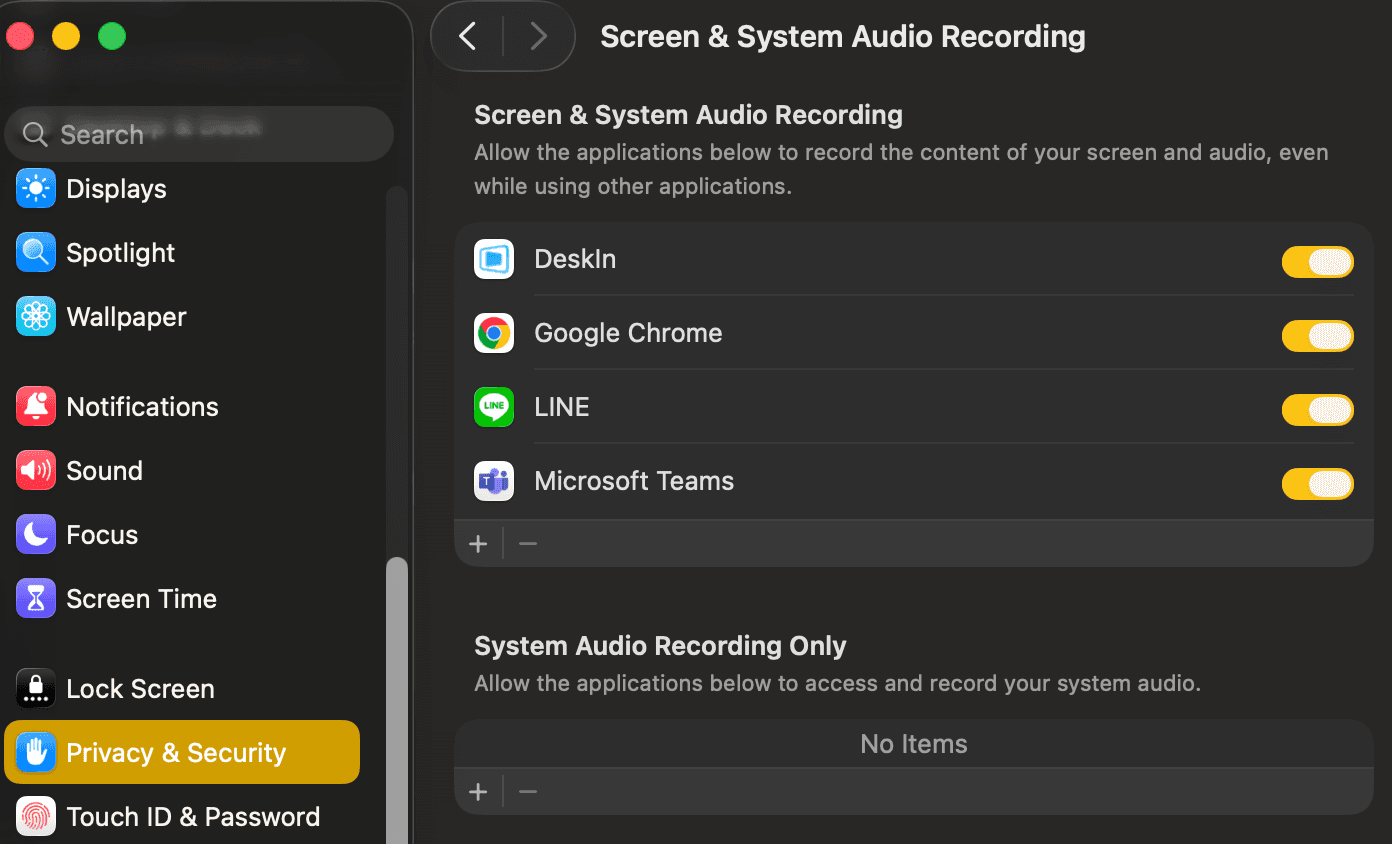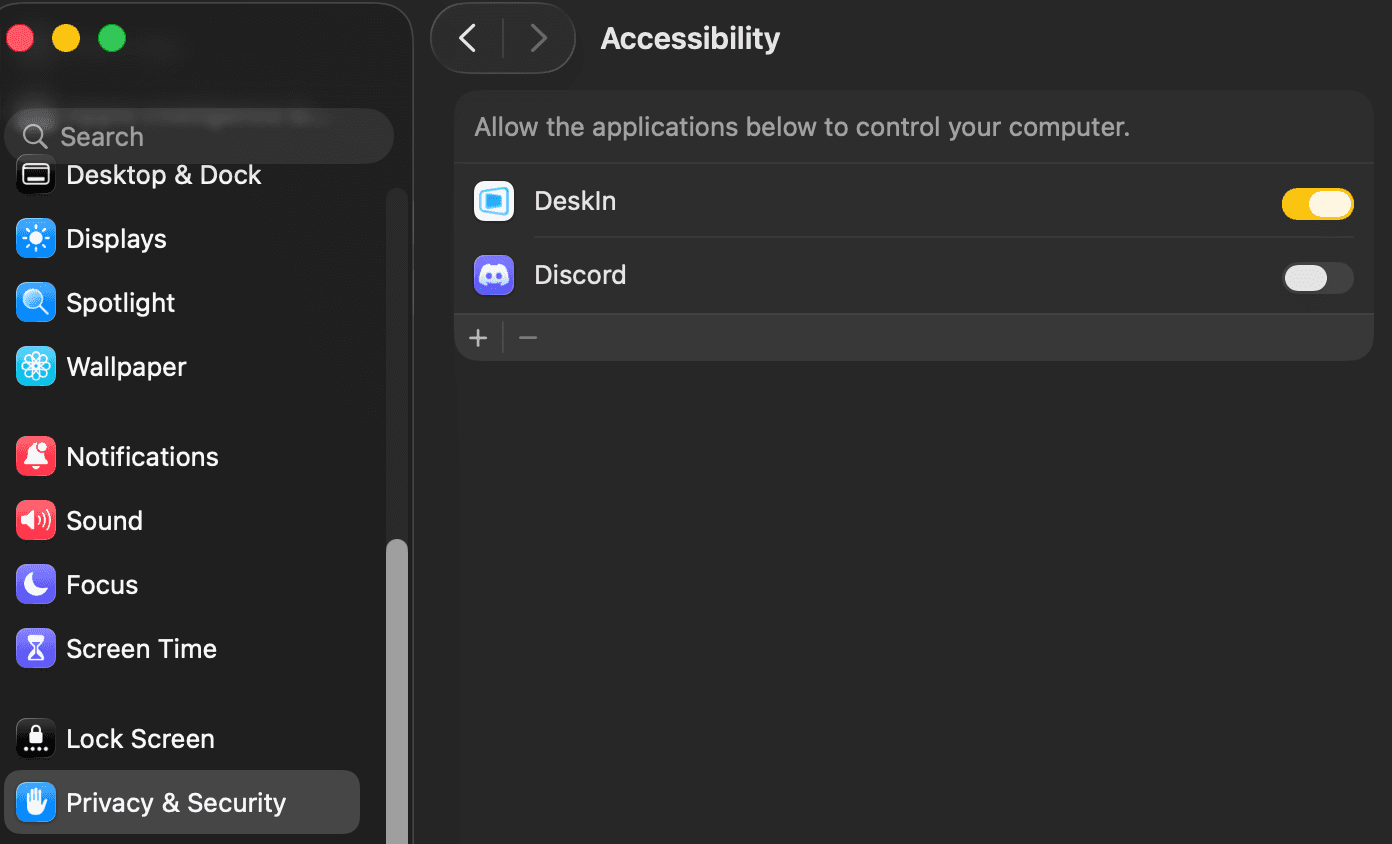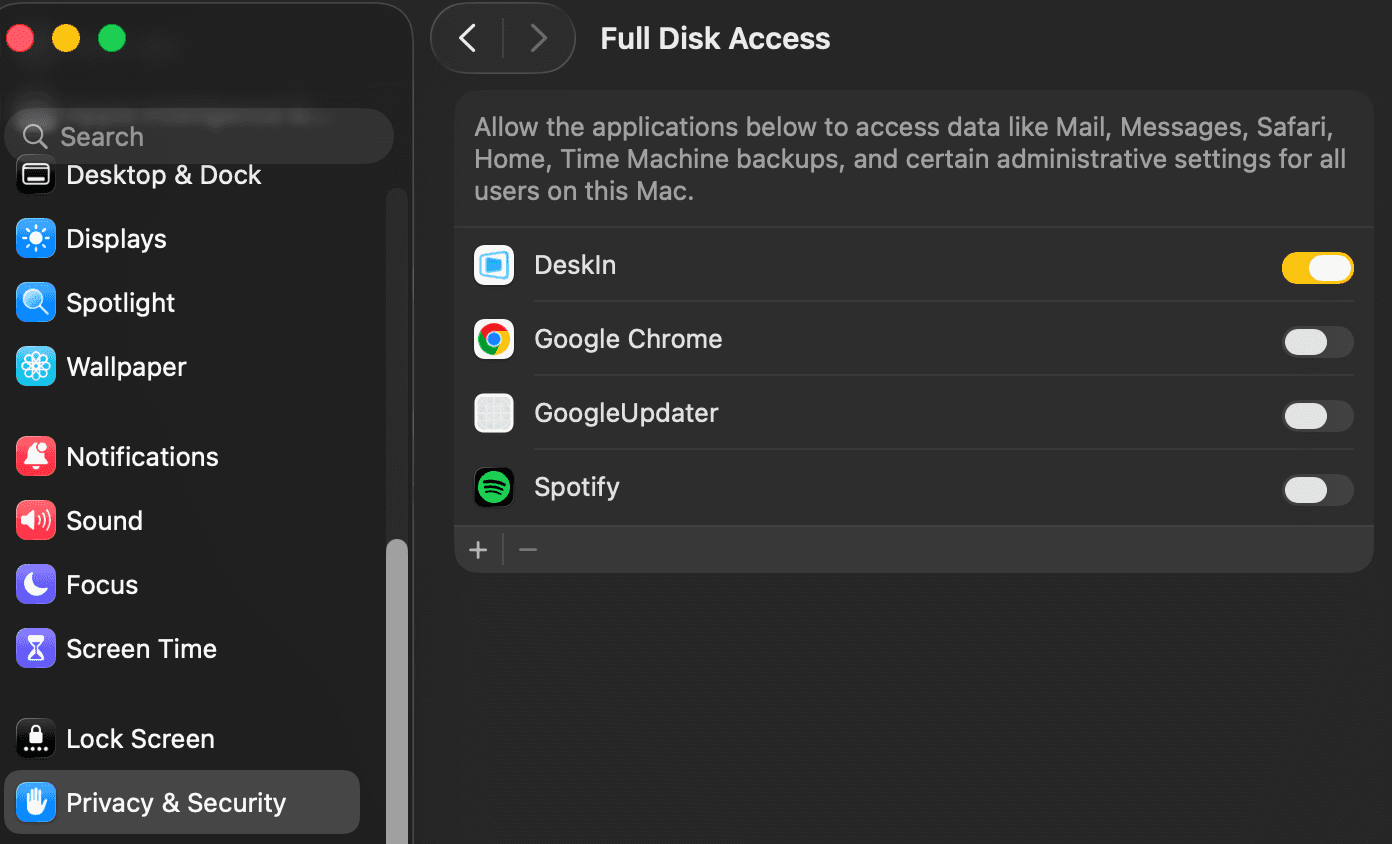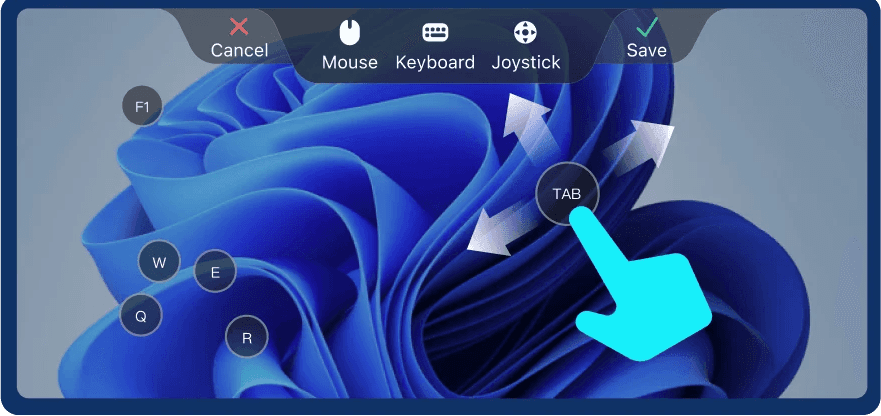您是否也曾遇過臨時需要存取家裡或辦公室的電腦,處理緊急文件、修改簡報,或是進行系統維護,卻發現電腦處於關機狀態?無論是遠端工作者、IT管理員,還是需要彈性辦公的您,都可能面臨無法立即啟動遠端電腦的困擾。
如果還在尋找最佳方式,別擔心,這篇文章就是為了解決您的困擾而寫的。我們將一步步引導您,如何透過更簡單穩定的方式,輕鬆實現遠端開機。無論您是科技新手還是專業人士,都能快速上手,從此不再受距離限制,隨時隨地都能喚醒您的電腦,讓遠端工作真正暢行無阻!
什麽是WOL?
WOL(Wake-on-LAN)簡單來說是一種用另一台電腦或手機發送「魔法封包」(Magic Packet),以透過網路遠端啓動電腦的技術。
實現遠端開機有 2 種方法,一是可以通過傳統的WOL 開機,但會經歷複雜的路由器設定,不僅對新手不友好,而且不太穩定,另一種方法就是使用 DeskIn 輔助喚醒,DeskIn 可以透過手機/電腦等裝置輔助的方式,免於複雜的路由器設定,輕鬆實現遠端開機,還能將你的就裝置利用起來。

2 大電腦遠端開機方法對比
傳統 WOL 功能 | ||
設定 | 設定簡單更穩定:免於複雜路由器設定,簡單2步就能完成,只要 DeskIn 在運作就能遠端喚醒。 | 設定步驟複雜:需要進入路由器後台進行連接埠轉發、固定IP分配等複雜的網路設定,對不熟悉網路技術的使用者來說門檻很高 |
靈活性 | 更靈活:對比其他遠端桌面只能用電腦作爲輔助喚醒裝置,DeskIn支援使用移動裝置甚至是舊手機,版本最低支援到 Android5.0。 | 裝置限制多:通常僅能透過同一區域網路下的電腦發送魔術封包。從外部網路喚醒需依賴DDNS或公共IP,且網路環境變動易導致失效。 |
其他功能 | 進階功能:除了遠端喚醒,DeskIn 也是一款穩定、低延遲的遠端桌面,遠端開機之後,你還可以用本地電腦操控遠端電腦,甚至進行檔案傳輸。 | 單一功能:WOL 僅負責「開機」這一個動作,後續的遠端操作必須依賴另一套獨立的遠端控制軟體. |
安全性 | 安全管理與維護:企業敏感資料存於本地電腦比存儲在雲端更安全,透過DeskIn企業可以隨時喚醒遠端電腦進行資料存取、裝置運維管理,DeskIn使用256位元加密技術,節省成本同時也更安全。 | 存在資安風險:WOL協定本身缺乏加密與身份驗證。只要知曉MAC位址與公網IP,理論上任何人都可嘗試喚醒您的電腦,有潛在風險。 |
【最佳方法】使用 DeskIn 遠程啓動你的 Windows 電腦
使用 DeskIn 遠端啟動你的 Windows 電腦,不僅能實現開機,更能無縫接軌後續的完整操作。不同于傳統 WOL 功能僅能做到喚醒,DeskIn 讓你在電腦啟動後直接進行遠端存取與控制。這意味著你可以隨時取得所需的檔案、與同事共享螢幕進行協作,或執行任何必要的 IT 維護工作。將複雜的開機程序與直覺的遠端控制合而為一,提供一個穩定且安全的整合性解決方案,大幅超越了傳統僅具單一功能的喚醒技術。

使用DeskIn設定WOL遠端啓動電腦需要什麽條件
主板要求:Windows電腦主機板需支援Wake-on-LAN(WOL)——可透過查看主機板説明書、檢查網卡型號、聯絡產品客服等方式確認。電腦提前安裝好DeskIn并接上網路線。
輔助裝置:需有一台正在運行 DeskIn 的輔助喚醒裝置與待開機的電腦在同一局域網內用於輔助喚醒。例如其他Windows/Mac電腦、iPhone、iPad、Android 手機、平板等,需提前安裝好DeskIn。
系統條件:Linux 裝置不支援發送 WOL 封包,而 Mac 和 Linux 裝置不支持遠程開機。
狀態條件:處於藍屏或崩潰等異常關機狀態的Windows裝置不裝置遠程開機。
❗注意:大部分的筆電(尤其無線網卡)或是較舊的電腦(10年前的)不支援使用WOL,無線網路通常不支援,推薦使用有線網路。
💻如果需要使用 DeskIn 進行遠程喚醒,提前完成簡單的無人值守連線設定,您的電腦就可以在遠端喚醒之後隨時連接並遠端操控,立即下載 DeskIn 試試!

在設定前,請確保你已經下載并安裝 DeskIn,建議注冊一個帳號並登入,可以在裝置列表找到你需要啓動的裝置。
📺超好用!在外「遠端開電腦」?設定免費遠端開機!Windows 11 無人值守訪問?華碩主機板遠端喚醒?你想要的功能盡在DeskIn!
步驟1:網卡設置
在 Windows 右鍵Windows Logo,打開「裝置管理員」
找到並展開「網絡介面卡」選項。
找到你的網路孔網卡(如Realtek Gaming GbE Family Controller),右鍵>>然後點「内容」。

在下一個窗口中,導航至「電源管理」選項卡,並勾選打開「允許這個裝置喚醒電腦」

切換到「進階」選項卡,在内容中找到「收到Magic封包時喚醒」並啓用。若有「網路喚醒」相關選項,也請啓用

步驟2:主板 BIOS 設定
在電腦開機時,連續按 Delete 或是 F2 進入 BIOS
導航至「進階」選項卡 >> 「進階/高級電源管理」>> 開啓「PCI-E喚醒」,按 F10 儲存設定並重啟即可。可能為以下類似的名稱:
PCIE/PCI 設備開機
Power On By PCI-E
板載局域網開機
局域網喚醒
局域網恢復
PME 開機
注意:不用品牌的名稱可能有所差異,你可以Google你使用的主板的官方説明預計網路喚醒設定教學找到。

步驟3:在 DeskIn 設置中啟用遠程開機支持
若你使用行動裝置作爲輔助喚醒裝置,請前往DeskIn設定>>設定>>開啓「遠端開機支援Wake On LAN」

步驟四:遠端喚醒電腦
現在,你就可以使用DeskIn遠端啓動電腦了。只需在裝置列表找到你關機的裝置,會提醒「設備已離線」,按下「遠端開機」,等待數秒,你就能看到你的電腦已經開機並是可被連線的狀態了。

DeskIn:最安全、穩定的遠端桌面軟體,隨時隨地想連就連!
DeskIn是一款穩定、安全、高清無延遲的遠端軟體,支援Windows、Mac、iOS和Android系統,可以讓你隨時隨地用手機、筆電、平板就能連回遠端的電腦並進行存取和操作,是遠端辦公、遠端IT支援的必備軟體。就算您的電腦關機,您也可以使用DeskIn遠端啓動您的電腦,並透過設定安全的連線密碼,隨時隨地進行無人值守連線。DeskIn遠端桌面的優勢如下:
跨系統支援:支援Windows、Mac、iOS和Android跨平臺遠端操作,無縫串聯。
支援無人值守和遠端啓動功能,可用性超高。
超高連線品質:40ms超低延遲,支援最高4K60FPS&2K144FPS。
易用:界面直覺,使用簡單,無需複雜設定。
安全:256位元加密,端到端連線,保證資訊不外泄。還可以設定安全密碼、黑白名單,開啓螢幕遮罩保護操作内容不被看到。

更多閲讀:
【方法拓展】啓用 WOL 遠端喚醒家裏桌上型電腦
Wake-on-LAN(WOL)「網路喚醒」技術,是透過區域網路或網際網路,向目標電腦的網路卡發送一個特殊的「魔術封包」(Magic Packet),當遠端電腦收到網路訊號/訊息時,便可立即開機。這項功能最適合用於區域網路內的桌上型電腦,多數筆電較不支援此喚醒方式。
想透過 WOL 功能遠端啟動電腦,必須先完成一些基本設定。首先要在主控端設備上準備好傳送魔術封包的工具,然後在被控端電腦(也就是您想遠端開機的那台)中,開啟 BIOS 與作業系統中的「魔術封包喚醒」(Wake on Magic Packet)或 WOL 相關選項,然後再使用第三方軟體傳送網路訊號。不確定從哪裡開始,請直接跟著以下的詳細的 Wake on Lan 教學開始操作吧!
開始之前:事前準備與必備條件
請確認你的主機板必須具備網路喚醒(WOL)的功能。進入BIOS/UEFI設定畫面,在「電源管理」(Power Management)或「進階」(Advanced)等選單中,尋找如「Wake on LAN」、「Power on by PCI-E Device」等選項。如果存在該選項,即代表支援。再者,你家裡的分享器也要有支援網路喚醒的功能,最後是你家裡必須是固定 IP。
步驟一:配置操作系统中的网卡
單機右鍵找到「裝置管理員」,點擊「網路界面卡」> 「内容」

步驟二:開啓電源管理裏面的快速啓動和休眠功能
首先,找到「控制台」>「硬體和音效」。

從視窗左側點選「選擇按下電源按鈕時的行為」>「變更目前無法使用的設定」。

點選「開機設定」中所有選項都已勾選,這些選項允許裝置喚醒電腦,記得單擊儲存變更。

步驟三:進主机 BIOS 設定網路喚醒
接下來,您還需要在主機板的BIOS中啟用網路喚醒功能。開機並不斷按下 F2 或者 Del 鍵進入BIOS,在 「進階」、「电源管理」或「APM配置」 中,找到「Wake on LAN」、「Power On by PCI-E」 等相关选项,确保其状态为「開啟」,按 F10儲存並離開 BIOS。重新啟動電腦後,即可開啟網路喚醒功能。
各家主機介面不一,設定方式可能都不一樣,如果上述步驟不符,也自行可以搜尋「主機板廠商 網路喚醒」或是「筆電廠商 網路喚醒」。

步驟四:遠端喚醒電腦
接下來要使用工具來「發送」開機指令。前往 NirSoft 網站,下載並安裝NirSoft WakeMeOnLAN軟體。該軟體擁有直觀的視窗和按鈕,無需輸入指令,只需透過滑鼠點選,就能完成掃描區域網路內的電腦並發送魔法封包的操作。
開啟軟體後,點擊左上角的 「File」 選單,並選擇 「Start Scanning」,軟體便會自動掃描區域網路內所有支援網路喚醒的電腦。
如果您希望手動新增特定電腦,可以點擊 「File」 選單中的 「Add New Computer」 來進行設定。

掃描完成後,所有找到的遠端電腦會顯示在清單中。在想喚醒的電腦上按一下滑鼠右鍵,並選擇 「Wake Up Selected Computers」。

再單擊彈窗中的「Yes」進行確認,即可遠端喚醒電腦。

推薦閲讀:
遠端開啓電腦常見問題
Q1:電腦關機還可以遠端開機嗎?
電腦關機狀態下通常無法直接遠端開機,除非設備支援 Wake-on-LAN(WOL) 功能。但如果您想實現跨平台即時控制與螢幕操作,DeskIn 提供穩定的遠端桌面解決方案,讓您即便不在電腦旁,也能高效管理工作與多裝置協作。
Q2:我可以從世界任何地方喚醒家中的電腦嗎?
當然可以!您完全可以從世界任何地方喚醒家中的電腦。關鍵在於讓外部的開機指令能成功送達您家中的區域網路。
傳統方法是透過路由器設定「連接埠轉發」,並搭配動態域名服務,讓魔法封包能從外部網路正確轉送到您的電腦。不過這個方法需要一定的網路知識,設定較為複雜且可能不穩定。
現在有更簡單的解決方案!使用像 DeskIn 這樣的遠端控制軟體,您只需要在家中準備一台舊手機或平板作為輔助裝置。當您在外地想開機時,只需透過 App 發送指令,家中的輔助裝置就會自動在區域網路內幫您喚醒電腦,完全不需要複雜的路由器設定。
無論採用哪種方式,都能實現跨網域遠端開機,讓您隨時隨地都能存取家中電腦的資料。

Q3:電腦被遠端喚醒後,我該如何登入系統呢?
WOL 只負責「開機」,相當於您按下了電腦的電源鍵。要實際操作電腦,您需要另外搭配遠端桌面軟體,例如 DeskIn、Windows內建的「遠端桌面」、Chrome Remote Desktop,並將其設定為開機自動啟動。
>>延伸閲讀: Chrome遠端桌面可以進行無人值守嗎?
使用 DeskIn,隨時隨地想連就連!
總結來說,傳統 WOL 是透過網路傳送魔術封包的基礎技術,雖然免費但需要複雜的路由器設定與網路知識,穩定性較低且僅具單一開機功能。而 DeskIn 則是以 WOL 技術為基礎的現代化解決方案,免去路由器複雜設定,只需利用舊手機作為輔助裝置就能一鍵開機,並能無縫接軌後續的遠端控制操作。
對於追求效率與便利性的使用者,我們特別推薦 DeskIn 解決方案。它不僅完美解決了傳統 WOL 的設定門檻問題,更整合了完整的遠端桌面功能,讓您從開機到操作都能在同個平台上流暢完成,真正實現隨時隨地存取遠端電腦的無縫體驗。
💻 現在就免費下載 DeskIn,體驗這款真正適合每個人的遠端開機方案!

您是否也曾遇過臨時需要存取家裡或辦公室的電腦,處理緊急文件、修改簡報,或是進行系統維護,卻發現電腦處於關機狀態?無論是遠端工作者、IT管理員,還是需要彈性辦公的您,都可能面臨無法立即啟動遠端電腦的困擾。
如果還在尋找最佳方式,別擔心,這篇文章就是為了解決您的困擾而寫的。我們將一步步引導您,如何透過更簡單穩定的方式,輕鬆實現遠端開機。無論您是科技新手還是專業人士,都能快速上手,從此不再受距離限制,隨時隨地都能喚醒您的電腦,讓遠端工作真正暢行無阻!
什麽是WOL?
WOL(Wake-on-LAN)簡單來說是一種用另一台電腦或手機發送「魔法封包」(Magic Packet),以透過網路遠端啓動電腦的技術。
實現遠端開機有 2 種方法,一是可以通過傳統的WOL 開機,但會經歷複雜的路由器設定,不僅對新手不友好,而且不太穩定,另一種方法就是使用 DeskIn 輔助喚醒,DeskIn 可以透過手機/電腦等裝置輔助的方式,免於複雜的路由器設定,輕鬆實現遠端開機,還能將你的就裝置利用起來。

2 大電腦遠端開機方法對比
傳統 WOL 功能 | ||
設定 | 設定簡單更穩定:免於複雜路由器設定,簡單2步就能完成,只要 DeskIn 在運作就能遠端喚醒。 | 設定步驟複雜:需要進入路由器後台進行連接埠轉發、固定IP分配等複雜的網路設定,對不熟悉網路技術的使用者來說門檻很高 |
靈活性 | 更靈活:對比其他遠端桌面只能用電腦作爲輔助喚醒裝置,DeskIn支援使用移動裝置甚至是舊手機,版本最低支援到 Android5.0。 | 裝置限制多:通常僅能透過同一區域網路下的電腦發送魔術封包。從外部網路喚醒需依賴DDNS或公共IP,且網路環境變動易導致失效。 |
其他功能 | 進階功能:除了遠端喚醒,DeskIn 也是一款穩定、低延遲的遠端桌面,遠端開機之後,你還可以用本地電腦操控遠端電腦,甚至進行檔案傳輸。 | 單一功能:WOL 僅負責「開機」這一個動作,後續的遠端操作必須依賴另一套獨立的遠端控制軟體. |
安全性 | 安全管理與維護:企業敏感資料存於本地電腦比存儲在雲端更安全,透過DeskIn企業可以隨時喚醒遠端電腦進行資料存取、裝置運維管理,DeskIn使用256位元加密技術,節省成本同時也更安全。 | 存在資安風險:WOL協定本身缺乏加密與身份驗證。只要知曉MAC位址與公網IP,理論上任何人都可嘗試喚醒您的電腦,有潛在風險。 |
【最佳方法】使用 DeskIn 遠程啓動你的 Windows 電腦
使用 DeskIn 遠端啟動你的 Windows 電腦,不僅能實現開機,更能無縫接軌後續的完整操作。不同于傳統 WOL 功能僅能做到喚醒,DeskIn 讓你在電腦啟動後直接進行遠端存取與控制。這意味著你可以隨時取得所需的檔案、與同事共享螢幕進行協作,或執行任何必要的 IT 維護工作。將複雜的開機程序與直覺的遠端控制合而為一,提供一個穩定且安全的整合性解決方案,大幅超越了傳統僅具單一功能的喚醒技術。

使用DeskIn設定WOL遠端啓動電腦需要什麽條件
主板要求:Windows電腦主機板需支援Wake-on-LAN(WOL)——可透過查看主機板説明書、檢查網卡型號、聯絡產品客服等方式確認。電腦提前安裝好DeskIn并接上網路線。
輔助裝置:需有一台正在運行 DeskIn 的輔助喚醒裝置與待開機的電腦在同一局域網內用於輔助喚醒。例如其他Windows/Mac電腦、iPhone、iPad、Android 手機、平板等,需提前安裝好DeskIn。
系統條件:Linux 裝置不支援發送 WOL 封包,而 Mac 和 Linux 裝置不支持遠程開機。
狀態條件:處於藍屏或崩潰等異常關機狀態的Windows裝置不裝置遠程開機。
❗注意:大部分的筆電(尤其無線網卡)或是較舊的電腦(10年前的)不支援使用WOL,無線網路通常不支援,推薦使用有線網路。
💻如果需要使用 DeskIn 進行遠程喚醒,提前完成簡單的無人值守連線設定,您的電腦就可以在遠端喚醒之後隨時連接並遠端操控,立即下載 DeskIn 試試!

在設定前,請確保你已經下載并安裝 DeskIn,建議注冊一個帳號並登入,可以在裝置列表找到你需要啓動的裝置。
📺超好用!在外「遠端開電腦」?設定免費遠端開機!Windows 11 無人值守訪問?華碩主機板遠端喚醒?你想要的功能盡在DeskIn!
步驟1:網卡設置
在 Windows 右鍵Windows Logo,打開「裝置管理員」
找到並展開「網絡介面卡」選項。
找到你的網路孔網卡(如Realtek Gaming GbE Family Controller),右鍵>>然後點「内容」。

在下一個窗口中,導航至「電源管理」選項卡,並勾選打開「允許這個裝置喚醒電腦」

切換到「進階」選項卡,在内容中找到「收到Magic封包時喚醒」並啓用。若有「網路喚醒」相關選項,也請啓用

步驟2:主板 BIOS 設定
在電腦開機時,連續按 Delete 或是 F2 進入 BIOS
導航至「進階」選項卡 >> 「進階/高級電源管理」>> 開啓「PCI-E喚醒」,按 F10 儲存設定並重啟即可。可能為以下類似的名稱:
PCIE/PCI 設備開機
Power On By PCI-E
板載局域網開機
局域網喚醒
局域網恢復
PME 開機
注意:不用品牌的名稱可能有所差異,你可以Google你使用的主板的官方説明預計網路喚醒設定教學找到。

步驟3:在 DeskIn 設置中啟用遠程開機支持
若你使用行動裝置作爲輔助喚醒裝置,請前往DeskIn設定>>設定>>開啓「遠端開機支援Wake On LAN」

步驟四:遠端喚醒電腦
現在,你就可以使用DeskIn遠端啓動電腦了。只需在裝置列表找到你關機的裝置,會提醒「設備已離線」,按下「遠端開機」,等待數秒,你就能看到你的電腦已經開機並是可被連線的狀態了。

DeskIn:最安全、穩定的遠端桌面軟體,隨時隨地想連就連!
DeskIn是一款穩定、安全、高清無延遲的遠端軟體,支援Windows、Mac、iOS和Android系統,可以讓你隨時隨地用手機、筆電、平板就能連回遠端的電腦並進行存取和操作,是遠端辦公、遠端IT支援的必備軟體。就算您的電腦關機,您也可以使用DeskIn遠端啓動您的電腦,並透過設定安全的連線密碼,隨時隨地進行無人值守連線。DeskIn遠端桌面的優勢如下:
跨系統支援:支援Windows、Mac、iOS和Android跨平臺遠端操作,無縫串聯。
支援無人值守和遠端啓動功能,可用性超高。
超高連線品質:40ms超低延遲,支援最高4K60FPS&2K144FPS。
易用:界面直覺,使用簡單,無需複雜設定。
安全:256位元加密,端到端連線,保證資訊不外泄。還可以設定安全密碼、黑白名單,開啓螢幕遮罩保護操作内容不被看到。

更多閲讀:
【方法拓展】啓用 WOL 遠端喚醒家裏桌上型電腦
Wake-on-LAN(WOL)「網路喚醒」技術,是透過區域網路或網際網路,向目標電腦的網路卡發送一個特殊的「魔術封包」(Magic Packet),當遠端電腦收到網路訊號/訊息時,便可立即開機。這項功能最適合用於區域網路內的桌上型電腦,多數筆電較不支援此喚醒方式。
想透過 WOL 功能遠端啟動電腦,必須先完成一些基本設定。首先要在主控端設備上準備好傳送魔術封包的工具,然後在被控端電腦(也就是您想遠端開機的那台)中,開啟 BIOS 與作業系統中的「魔術封包喚醒」(Wake on Magic Packet)或 WOL 相關選項,然後再使用第三方軟體傳送網路訊號。不確定從哪裡開始,請直接跟著以下的詳細的 Wake on Lan 教學開始操作吧!
開始之前:事前準備與必備條件
請確認你的主機板必須具備網路喚醒(WOL)的功能。進入BIOS/UEFI設定畫面,在「電源管理」(Power Management)或「進階」(Advanced)等選單中,尋找如「Wake on LAN」、「Power on by PCI-E Device」等選項。如果存在該選項,即代表支援。再者,你家裡的分享器也要有支援網路喚醒的功能,最後是你家裡必須是固定 IP。
步驟一:配置操作系统中的网卡
單機右鍵找到「裝置管理員」,點擊「網路界面卡」> 「内容」

步驟二:開啓電源管理裏面的快速啓動和休眠功能
首先,找到「控制台」>「硬體和音效」。

從視窗左側點選「選擇按下電源按鈕時的行為」>「變更目前無法使用的設定」。

點選「開機設定」中所有選項都已勾選,這些選項允許裝置喚醒電腦,記得單擊儲存變更。

步驟三:進主机 BIOS 設定網路喚醒
接下來,您還需要在主機板的BIOS中啟用網路喚醒功能。開機並不斷按下 F2 或者 Del 鍵進入BIOS,在 「進階」、「电源管理」或「APM配置」 中,找到「Wake on LAN」、「Power On by PCI-E」 等相关选项,确保其状态为「開啟」,按 F10儲存並離開 BIOS。重新啟動電腦後,即可開啟網路喚醒功能。
各家主機介面不一,設定方式可能都不一樣,如果上述步驟不符,也自行可以搜尋「主機板廠商 網路喚醒」或是「筆電廠商 網路喚醒」。

步驟四:遠端喚醒電腦
接下來要使用工具來「發送」開機指令。前往 NirSoft 網站,下載並安裝NirSoft WakeMeOnLAN軟體。該軟體擁有直觀的視窗和按鈕,無需輸入指令,只需透過滑鼠點選,就能完成掃描區域網路內的電腦並發送魔法封包的操作。
開啟軟體後,點擊左上角的 「File」 選單,並選擇 「Start Scanning」,軟體便會自動掃描區域網路內所有支援網路喚醒的電腦。
如果您希望手動新增特定電腦,可以點擊 「File」 選單中的 「Add New Computer」 來進行設定。

掃描完成後,所有找到的遠端電腦會顯示在清單中。在想喚醒的電腦上按一下滑鼠右鍵,並選擇 「Wake Up Selected Computers」。

再單擊彈窗中的「Yes」進行確認,即可遠端喚醒電腦。

推薦閲讀:
遠端開啓電腦常見問題
Q1:電腦關機還可以遠端開機嗎?
電腦關機狀態下通常無法直接遠端開機,除非設備支援 Wake-on-LAN(WOL) 功能。但如果您想實現跨平台即時控制與螢幕操作,DeskIn 提供穩定的遠端桌面解決方案,讓您即便不在電腦旁,也能高效管理工作與多裝置協作。
Q2:我可以從世界任何地方喚醒家中的電腦嗎?
當然可以!您完全可以從世界任何地方喚醒家中的電腦。關鍵在於讓外部的開機指令能成功送達您家中的區域網路。
傳統方法是透過路由器設定「連接埠轉發」,並搭配動態域名服務,讓魔法封包能從外部網路正確轉送到您的電腦。不過這個方法需要一定的網路知識,設定較為複雜且可能不穩定。
現在有更簡單的解決方案!使用像 DeskIn 這樣的遠端控制軟體,您只需要在家中準備一台舊手機或平板作為輔助裝置。當您在外地想開機時,只需透過 App 發送指令,家中的輔助裝置就會自動在區域網路內幫您喚醒電腦,完全不需要複雜的路由器設定。
無論採用哪種方式,都能實現跨網域遠端開機,讓您隨時隨地都能存取家中電腦的資料。

Q3:電腦被遠端喚醒後,我該如何登入系統呢?
WOL 只負責「開機」,相當於您按下了電腦的電源鍵。要實際操作電腦,您需要另外搭配遠端桌面軟體,例如 DeskIn、Windows內建的「遠端桌面」、Chrome Remote Desktop,並將其設定為開機自動啟動。
>>延伸閲讀: Chrome遠端桌面可以進行無人值守嗎?
使用 DeskIn,隨時隨地想連就連!
總結來說,傳統 WOL 是透過網路傳送魔術封包的基礎技術,雖然免費但需要複雜的路由器設定與網路知識,穩定性較低且僅具單一開機功能。而 DeskIn 則是以 WOL 技術為基礎的現代化解決方案,免去路由器複雜設定,只需利用舊手機作為輔助裝置就能一鍵開機,並能無縫接軌後續的遠端控制操作。
對於追求效率與便利性的使用者,我們特別推薦 DeskIn 解決方案。它不僅完美解決了傳統 WOL 的設定門檻問題,更整合了完整的遠端桌面功能,讓您從開機到操作都能在同個平台上流暢完成,真正實現隨時隨地存取遠端電腦的無縫體驗。
💻 現在就免費下載 DeskIn,體驗這款真正適合每個人的遠端開機方案!








